Mmm, Italian cookies! These scrumptious treats are as diverse as the regions of Italy, plus each has a unique story to tell. From crunchy Cantucci to the melt-in-your-mouth Baci di Dama, cookies are a true representation of the country’s rich culinary heritage.
Whether you’re savouring them with a cup of coffee or enjoying them as a post-dinner dessert, these cookies are the perfect way to indulge your sweet tooth and satisfy your cravings for a taste of Italy.
So, let’s explore 10 of the most famous Italian cookies – one bite at a time!
Mmm, i biscotti italiani! Questi deliziosi dolcetti sono diversi tanto quanto le regioni che compongono la penisola, e ognuno ha una sua storia da raccontare. Dai Cantucci croccanti ai Baci di Dama che si sciolgono in bocca, i biscotti sono una rappresentazione perfetta del ricco patrimonio culinario del paese.
Sia che li gustiate con una tazza di caffè o come dessert dopo cena, questi biscotti sono il modo perfetto per soddisfare la voglia di dolce e sentire l’Italia un pò più vicina.
Scopriamo dunque 10 famosi biscotti italiani – un boccone alla volta!

This article is part of our Bilingual Blog series, where we share useful information and tips about non-language related aspects of Italian culture such as food, music, travel and more. These articles have been written in Italian and English to give our readers the opportunity to improve their reading skills whilst learning something new about Italy.
1. Savoiardi
Named after the Savoy dynasty, Savoiardi may appear very simple at first glance with their long and rather flattened shape resembling a thick finger, but one bite will reveal an exquisite texture that dissolves in your mouth and makes them truly delicious. Plus, these old-fashioned Italian cookies have quite an impressive history. Dating back to 1365, the recipe was originally created by the head baker of Count Amedeo VI of Savoy to impress none other than the Holy Roman emperor Charles IV. And impress him it did, as Amedeo was appointed imperial vicar that same year.
Chiamati così in onore della dinastia dei Savoia, a prima vista i Savoiardi possono sembrare biscotti semplici con la loro forma lunga e piuttosto piatta che ricorda un dito spesso. Tuttavia, un solo morso rivelerà la loro delicata consistenza, che si scioglie in bocca e li rende una vera bontà. Questi biscotti tradizionali italiani hanno una storia piuttosto interessante. La loro ricetta è stata creata nel 1365 dal fornaio del Conte Amedeo VI di Savoia per colpire l’imperatore del Sacro Romano Impero, Carlo IV. E di sicuro ci riuscì, dal momento che Amedeo fu nominato vicario imperiale in quello stesso anno.
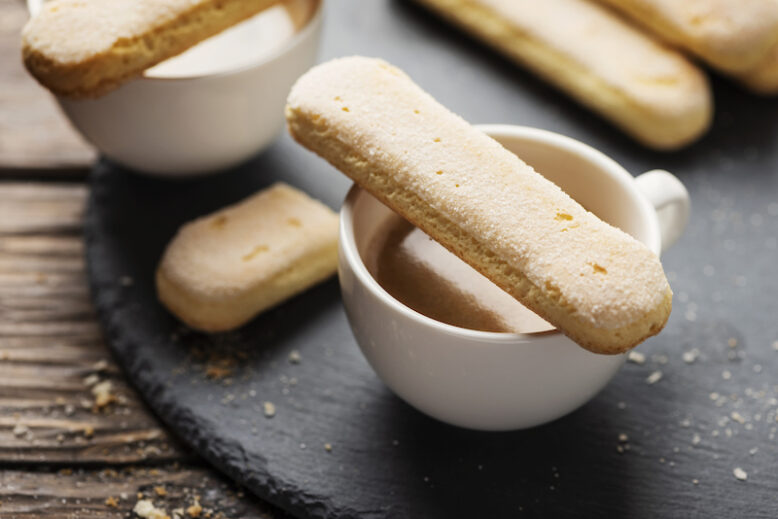
2. Baci di Dama
Baci di Dama are the pride and joy of Piedmontese patisserie. Literally translated to Lady’s Kisses, these delectable treats get their name from their unique shape: two crumbly biscuits that come together in a “kiss,” with a layer of rich dark chocolate in between. Ah, we Italians are so romantic! They were first created in the 19th century in a pastry shop in Tortona and quickly became a hit among the Savoy court and beyond. In 1906, they were even awarded the Gold Medal of pastry at the Milan international fair. Nowadays, you can find many variations of Baci di Dama. My favorite are the Baci di Alassio, which add cocoa and honey to the biscuit dough – yum.
I Baci di Dama rappresentano una delle eccellenze della pasticceria piemontese. Questi deliziosi dolci prendono il nome dalla loro forma unica: due biscotti friabili che si uniscono in un romantico “bacio”, con un cuore di cioccolato fondente. Ah, quanto siamo romantici noi italiani! Furono ideati per la prima volta nel XIX secolo in una pasticceria di Tortona, conquistando subito il palato della corte dei Savoia e non solo. Nel 1906, furono addirittura premiati con la medaglia d’oro alla fiera internazionale di Milano. Oggi, esistono molte varianti dei Baci di Dama. I miei preferiti sono i Baci di Alassio, in cui cacao e miele arricchiscono l’impasto del biscotto – una vera delizia.
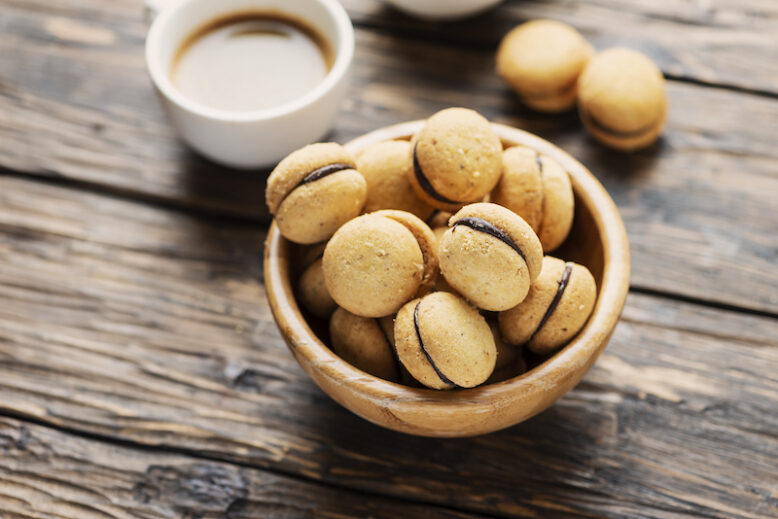
3. Krumiri
Krumiri are beloved Italian cookies with a uniquely curved and streaked shape, inspired by the moustache of King Vittorio Emmanuel II. History has it that the recipe for Krumiri was first concocted by the pastry chef Domenico Rossi during a night out with friends in Casale Monferrato back in 1878. What started as a fun experiment soon turned into a culinary sensation, as Krumiri quickly captured the hearts and palates of locals and visitors alike. The recipe was eventually patented in 1886, and to this day, these delicious cookies can be purchased in the same pastry shop in Casale Monferrato, where Krumiri are still made by hand, one by one, and sold in iconic red tin boxes.
I Krumiri sono famosi biscotti italiani, la cui forma unica, curva e striata, si ispira al baffo di Re Vittorio Emanuele II. La storia narra che il pasticciere Domenico Rossi ideò la ricetta dei Krumiri per la prima volta durante una serata tra amici a Casale Monferrato nel 1878. Ciò che cominciò come un semplice esperimento, si trasformò presto in un successo culinario, conquistando i cuori e i palati dei locali e dei turisti. Nel 1886 la ricetta fu infine brevettata e, ancora oggi, questi deliziosi biscotti possono essere acquistati in quella stessa pasticceria a Casale Monferrato, dove vengono ancora fatti a mano, uno per uno, e venduti in iconiche scatole di latta rosse.
4. Brutti ma Buoni
Brutti ma Buoni (Ugly But Good cookies) are made with egg whites, sugar and hazelnuts, resulting in a delicate meringue texture that’s truly addictive. Their name says it all: they may not be the most aesthetically pleasing, but their taste is undeniably irresistible. It is believed they were first crafted in 1878 in the pastry shop of Costantino Veniani in Gavirate, a small town near Varese. The shop, which even obtained a patent from the Ministry of Agriculture, Industry and Commerce of the Kingdom of Italy at the time, still exists and its customers included the famed composer Giuseppe Verdi, who had quite a fondness for these cookies.
I Brutti ma Buoni sono dei biscotti realizzati con albumi d’uovo, zucchero e nocciole che insieme creano un irresistibile dolcetto dalla consistenza simile a una meringa. Come suggerisce il nome, potrebbero non essere il massimo dell’estetica, ma il loro sapore è indiscutibilmente delizioso. Si dice che siano stati creati per la prima volta nel 1878 nella pasticceria di Costantino Veniani a Gavirate, un paese vicino a Varese. La pasticceria, che ottenne persino un brevetto dal Ministero dell’Agricoltura, dell’Industria e del Commercio del Regno d’Italia all’epoca, esiste ancora e tra i suoi clienti c’è stato anche il celebre compositore Giuseppe Verdi, che aveva una grande passione per questi biscotti.

5. Ricciarelli
Ricciarelli transport us to beautiful Siena, where, according to chronicles, they were born in the 15th century. Shaped like rice grains and covered in a layer of rich icing sugar, Ricciarelli are soft almond biscuits named after the Sienese nobleman Ricciardetto Della Gherardesca, who brought Arab sweets of a similar shape to Siena upon returning from the Crusades. Back in the day, Ricciarelli were the stuff of lavish banquets and feasts, reserved only for Tuscan royalty since almond paste was a rather expensive ingredient. But today, all enjoy these famous Italian cookies, particularly at Christmastime when they pair perfectly with a glass of sweet dessert wine.
I Ricciarelli ci trasportano nella bellissima Siena, dove, secondo le cronache, nacquero nel XV secolo. Sono morbidi biscotti alle mandorle a forma di chicco di riso e coperti da un ricco strato di zucchero a velo. Il loro nome è un omaggio al nobile senese Ricciardetto Della Gherardesca, che di ritorno dalle crociate portò a Siena dolci arabi simili. Ai tempi, i Ricciarelli erano un vero e proprio tesoro culinario riservato solo alla nobiltà toscana, poiché la pasta di mandorle era un ingrediente costoso. Ma oggi tutti possono gustare questi famosi biscotti italiani, soprattutto durante le festività natalizie, quando si abbinano perfettamente a un bicchiere di vino dolce da dessert.
6. Cantucci
Cantucci are little treats made with almonds and baked twice for delightful crunchiness. These famous Italian cookies surely stood the test of time: it is said they were enjoyed already in ancient Rome as an easily-portable, non-perishable sweet bread for soldiers. But Renaissance Tuscany is when they really gained popularity, thanks to the creative touch of Caterina de’ Medici, who added whole almonds to the recipe, transforming Cantucci into the delicious cookies we know and love today. Typically, we eat them at the end of the meal, dipped in a glass of vin santo, a sweet dessert wine. Yet, Cantucci are also perfect to accompany coffee or tea for an indulgent treat at any time of the day.
I Cantucci sono dei dolcetti a base di mandorle, resi croccanti dalla doppia cottura. Questi famosi biscotti italiani hanno superato la prova del tempo: si racconta che già nell’antica Roma fossero molto apprezzati come pane dolce facilmente trasportabile e non deperibile per i soldati. Tuttavia, è in Toscana durante il Rinascimento che hanno raggiunto la massima popolarità, grazie alla creatività di Caterina de’ Medici, che arricchì la ricetta aggiungendo le mandorle intere e trasformando i cantucci nei biscotti che noi tutti oggi conosciamo e amiamo. Di solito li gustiamo alla fine del pasto, inzuppati in un bicchiere di vin santo. Tuttavia, i Cantucci sono perfetti anche per accompagnare il caffè o il tè per una coccola in qualsiasi momento della giornata.
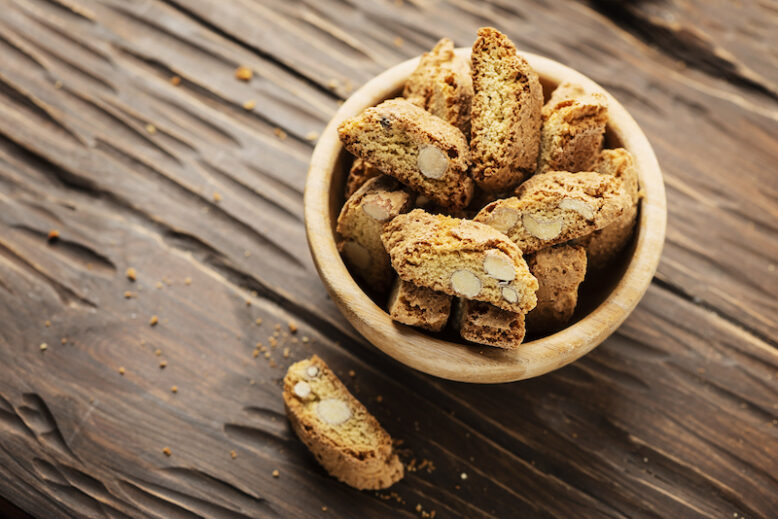
7. Canestrelli
These buttery Italian cookies are so special they even made it onto a coin! Dating back to the Middle Ages in the Genoese interior, Canestrelli were created during a time when flour was scarce. It was a clever merchant, who, despite the shortage, decided to prepare cute daisy-shaped cookies using white flour and butter. These cookies became such a regional hit that they were even celebrated on the Genovino d’oro (the coin symbol of the Maritime Republic of Genoa) as a symbol of abundance and wealth. Fast forward to 1829, Canestrelli officially went on sale in Torriglia, and today they are celebrated with the Canestrelletto Festival every June.
Questi biscotti burrosi sono talmente speciali da essere finiti addirittura su una moneta! Nati nell’entroterra genovese durante il medioevo, i Canestrelli sono stati creati in un periodo in cui la farina era scarsa. Questo infatti non ha fermato un arguto commerciante dal preparare simpatici biscotti a forma di margherita usando farina bianca e burro. Questi biscotti hanno avuto un tale successo in tutta la regione da apparire persino sul Genovino d’oro (la moneta simbolo della Repubblica Marinara di Genova) come simbolo di abbondanza e ricchezza. I Canestrelli sono stati poi ufficialmente messi in vendita a Torriglia nel 1829 e oggi sono celebrati con uno speciale Festival del Canestrelletto ogni giugno.
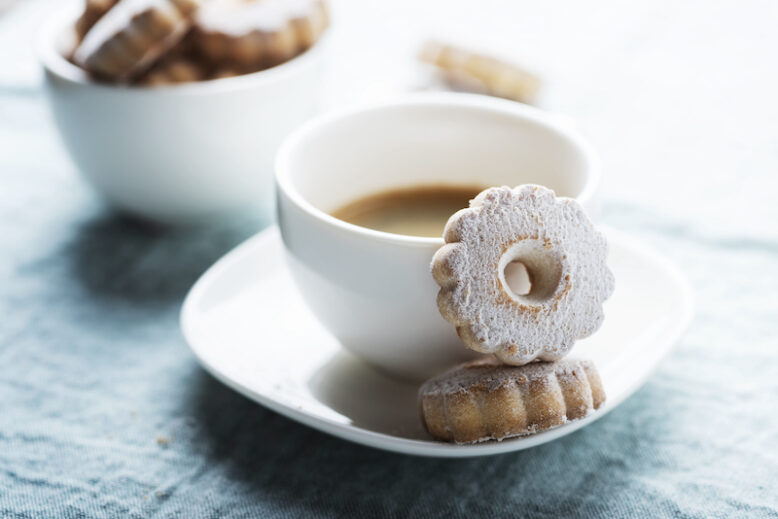
8. Torcetti
Torcetti are crunchy ring-shaped cookies born from the regions of Piedmont and Valle d’Aosta. Lightly sugared, they are not overly sweet, which is a good thing since it’s hard to stop when you eat them! They were first mentioned in records in the 18th century and were once humble bread-based snacks for children when families cooked bread in communal ovens. Then, butter was added to the dough, making them even more decadent. Today, Torcetti are a popular pastry product and the perfect accompaniment to any drink. But try dunking them in hot chocolate – it’s a match made in cookie heaven!
I Torcetti sono croccanti biscotti a forma di anello, originari delle regioni del Piemonte e della Valle d’Aosta. Leggermente zuccherati, non sono eccessivamente dolci, il che è un bene dato che è difficile smettere di mangiarli! Ve ne è traccia scritta a partire dal XVIII secolo e inizialmente erano semplici snack per i bambini a base di pasta di pane ai tempi in cui le famiglie cuocevano il pane nei forni comuni. Successivamente, la ricetta è stata arricchita dall’aggiunta del burro, che li ha resi ancora più gustosi. Oggi i Torcetti sono un prodotto di pasticceria molto apprezzato, perfetto da gustare con qualsiasi bevanda. Ma provate ad inzupparli nella cioccolata calda – una vera bontà!

9. Amaretti
Amaretti are dome-shaped cookies made with almonds. They get their curious name from the word amaro (bitter), which is a nod to the sharp flavour of bitter almonds traditionally used in the recipe. The origins of these famous Italian cookies are as varied as the ways they are made throughout Italy. You can find them soft and chewy, dry and crispy, and even scented with different flavourings. We serve amaretti with dessert wines or coffee when entertaining guests or give them as a thoughtful gift. We also use them in savoury dishes like Tortelli di Zucca (ravioli stuffed with pumpkin and amaretti).
Gli amaretti sono biscotti a base di mandorla e dalla curiosa forma di cupola. Il loro curioso nome curioso fa riferimento al sapore deciso delle mandorle amare tradizionalmente utilizzate nella ricetta. Le origini di questi famosi biscotti italiani sono molteplici, così come le varianti preparate in tutta Italia. Possono essere morbidi, croccanti e aromatizzati in vario modo. Solitamente, vengono serviti insieme a un bicchiere di vino dolce o una tazza di caffè quando si hanno ospiti, oppure regalati. Gli amaretti sono anche utilizzati come ingrediente in piatti salati, come ad esempio i tortelli di zucca.
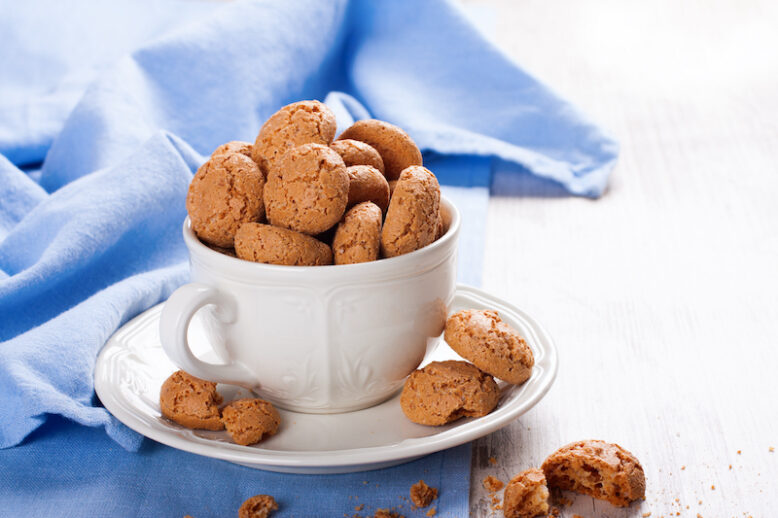
10. Paste di Mandorla
If you’ve read up to this point, you’ve probably gathered that in Italy, we are nuts about almonds (pun intended!). So here’s another famous almond-based Italian cookie straight from Sicily: Pasta di Mandorle! These chewy cookies decorated with toasted almonds or candied cherries are a true icon of Sicilian confectionery. It was the nuns of the convent of the Martorana in Palermo who first created these sweet gems back in 1100, inspired by the Arab custom of mixing almonds with sugar to delight the palate. They are often served as a tray of assorted Paste di Mandorle at the end of a family lunch and are the perfect treat to savour with a cup of coffee.
Ecco un altro famoso biscotto italiano a base di mandorle, questa volta direttamente dalla Sicilia: le Paste di Mandorla! Questi morbidi biscotti decorati con mandorle tostate o ciliegie candite sono una vera icona della pasticceria siciliana. Furono le suore del convento della Martorana a Palermo a creare per la prima volta questi dolci nel 1100, ispirandosi alla tradizione araba di mescolare mandorle e zucchero per deliziare il palato. Sono spesso serviti in vassoi assortiti alla fine di un pranzo in famiglia e sono ottimi con una tazza di caffè.
Valentina is a travel writer in love with her country. Having travelled widely around the globe, she realised there was more to explore closer to home and decided to put the passport aside for a while. You can follow her adventures around Italy on her blog myitaliandiaries.com.

Valentina Nicastro is a travel writer in love with her home country, Italy. Having travelled widely around the globe, she realised there was more to explore closer to home and decided to put the passport aside for a while. When she is not immersed in documenting Italy, you’ll find her donning her communication consultant hat, weaving words as a content writer and bridging linguistic divides as a translator.


